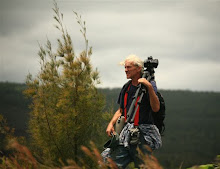 USGS/HVO images page caption states, "This photograph, looking east, shows a large skylight on the lava tube that is supplying lava to surface flows north of Royal Gardens subdivision. The tube trace, which heads southeast, is marked by the line of fume sources in the upper right portion of the image. The surface flows, out of view in this image, were 1.1 km (0.7 miles) north of the uppermost street in Royal Gardens today." Closer look at that huge skylight:
USGS/HVO images page caption states, "This photograph, looking east, shows a large skylight on the lava tube that is supplying lava to surface flows north of Royal Gardens subdivision. The tube trace, which heads southeast, is marked by the line of fume sources in the upper right portion of the image. The surface flows, out of view in this image, were 1.1 km (0.7 miles) north of the uppermost street in Royal Gardens today." Closer look at that huge skylight:  photos courtesy USGS. Click any images for a larger size in new window.
photos courtesy USGS. Click any images for a larger size in new window.Residents of Kalapana Gardens community have been notifying me that in recent days they can see, after dark, surface lava just above the area that once was the Royal Gardens subdivision. (The subdivision has been repeatedly inundated with lava flows since the early & mid 1980’s; only one home, apparently still occupied, remains intact.) Coastal lava abruptly stopped flowing on March 5th this year when a violent fissure erupted southwest of Pu`u O`o crater, which also significantly collapsed inside. The crater rebuilt its floor, collapsed again with another fissure rupture in August, and rebult again, only this time the fissures have been draining more steadily from the most recent southeast crater flank.
Leading easterly from that fissure on the southeast flanks of the Pu`u O`o crater, active lava tubes have been formed, insulating and carrying the lava further towards the coast. As depicted in the tilt graphs below, an up tick of inflation/deflation magma pressure cycling has likely helped to create this situation. Below - Nov. 9th to the 16th:
 and today's graph: 14th to 21st -nearly consistant day and a half pulses for the past two weeks or so - more closely spaced than previous weeks/months, which were averaging around 2 to 3 days per D/I cycle.
and today's graph: 14th to 21st -nearly consistant day and a half pulses for the past two weeks or so - more closely spaced than previous weeks/months, which were averaging around 2 to 3 days per D/I cycle. 
Current USGS/HVO flow maps, below and last updated on November 21st, show in red the new advancement of the lava, which is reported to be pahoehoe on the leading edge. This leading front is now about 3 ½ miles, or 5 kilometers, from Pu`u O`o and about a half mile north by northwest of Royal Gardens, and also about a half mile east of the national park boundaries. This puts the distance to the nearest coastline at around 4 miles or 6 ½ kilometers.
 Click on images for large size
Click on images for large size
If this flow of lava continues on its present track it will soon begin reaching the steeper terrain of the Pulama Pali, which could escalate advancement if magma pressures within Kilauea remain in this more compact cyclic pattern, or simply has a prolonged-sustained rise; time will tell.
As always, you can keep informed on Kilauea’s volcanic activity by following the USGS Hawaiian Volcano Observatory updates and associated links.










It's nice to have the lava visible again. We have a trip to the Big Island in January, and are hoping for some visible lava flows by then, so we're anxiously checking your blog regularly. Thanks for the updates.
ReplyDelete